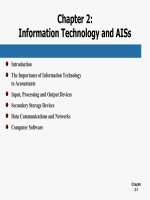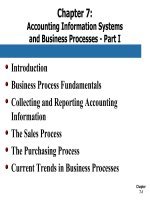Accounting information systems 12th SIMKIN and norman chapter 15
Bạn đang xem bản rút gọn của tài liệu. Xem và tải ngay bản đầy đủ của tài liệu tại đây (464.49 KB, 37 trang )
Chapter 15:
Accounting and Enterprise Software
Introduction
Integrated Accounting Software
Enterprise-Wide Information Systems
Selecting a Software Package
Chapter
15-1
Introduction
Advances in Accounting Software
Initially processed bookkeeping transactions
Developed into powerful and complex data
collection programs
Enterprise Resource Planning Systems (ERP)
Provide all accounting functions
Interfaced with multiple functional areas of
business
Manufacturing, Sales and Distribution, HR
Applications
Chapter
15-2
Integrated Accounting
Software
Function
Process all types of accounting transactions
Transactions affecting general and special journals
Modules
Organizes transaction processing in modules
Provides links between modules
Include Accounts Receivable, Accounts Payable,
Inventory, and Payroll
Chapter
15-3
Features of Integrated
Accounting Software Programs
Chapter
15-4
Small Business Accounting
Software
Information Needs of Small Business Owners
Cash Flows
Evaluating Profitability
Popular Software Packages
Quickbooks by Intuit
Peachtree Accounting
Chapter
15-5
Small Business Accounting
Software
Features of Software
Vary by provider
Numerous reports including financial statements and
budget reports
Scalability
Internet Connectivity
Adoption
Owners must still learn the various features of the
programs
Chapter
15-6
Midrange and Large-Scale
Accounting Software
Utilization
Transaction processing needs grow
Volume and complexity
Popular Software Packages
Microsoft Dynamics GP
SAP Business One
Epicor
Sage software’s MAS 90, MAS 200
Everest
Chapter
15-7
Midrange and Large-Scale
Accounting Software
Cost Considerations
Range from $2,000 to over $300,000
Features
Multi-currency transactions
Currency conversions
Various modules and interfaces (CRM, HR)
Deployment options (desktop, web-browser)
Hosted solutions
Chapter
15-8
Midrange Accounting
Software Integration
Chapter
15-9
Specialized Accounting
Information Systems
Specially designed software for specific industries
Schools, Dental Offices, Pet Retailers
Can be designed as add-on modules for integrated
software packages
Independent developers create programs to
interface with integrated packages
Chapter
15-10
Study Break #1
Which of the following accounting software programs would
be appropriate for a small business (e.g., a sole proprietorship
with 20 employees)?
A.SAP
B.QuickBooks
C.NetSuite
D.Oracle
Chapter
15-11
Study Break #1 - Answer
Which of the following accounting software programs would
be appropriate for a small business (e.g., a sole proprietorship
with 20 employees)?
A.SAP
B.QuickBooks
C.NetSuite
D.Oracle
Chapter
15-12
Study Break #2
Mid-level accounting software:
A.Can only be deployed through a server networked with
desktop computers
B.May be purchased in modules that match various business
processes
C.Will not be appropriate for a multinational company
because these programs cannot handle foreign currencies
D.Is generally inappropriate for a company operating in a
specialized industry, such as retail or not-for-profit
Chapter
15-13
Study Break #2 - Answer
Mid-level accounting software:
A.Can only be deployed through a server networked with
desktop computers
B.May be purchased in modules that match various business
processes
C.Will not be appropriate for a multinational company
because these programs cannot handle foreign currencies
D.Is generally inappropriate for a company operating in a
specialized industry, such as retail or not-for-profit
Chapter
15-14
Enterprise-Wide Accounting
Software Solutions
Enterprise Resource Planning Systems (ERP)
Enterprise software and Business application suites
Integrated program with central database
Popular Products
Microsoft Dynamics AX
SAP All-in-One
Oracle
Sage MAS 500
Chapter
15-15
Enterprise System
Functionality
Basic ERP Functions
Integration among major business processes
Order processing and Fulfillment, Manufacturing,
Purchasing, and Human Resources
Extended ERP Systems
Back-office functions
Front-office functions
Chapter
15-16
Extended ERP Systems
Supply Chain Management (SCM)
Customer Relationship Management (CRM)
Business Intelligence Tools (BI)
Partnership Relationship Management (PRM)
Chapter
15-17
ERP System Integration
Chapter
15-18
Supply Chain Example
Chapter
15-19
The Architecture of
Enterprise Systems
Chapter
15-20
The Architecture of
Enterprise Systems
Systems Configurations
Often run on company’s system
Hosted solutions help alleviate risks
Centralized Database
Each data item stored once
Prevents data redundancy
Data immediately available to all business functions
Chapter
15-21
The Architecture of
Enterprise Systems
Application Interfaces
Best-of-breed approach
Enterprise application integration(EAI)
Internet Portals
Gateways to other web sites
Enhances communication and productivity among
employees, customers, partners, and suppliers
Chapter
15-22
Study Break #3
Which of the following is distinguishing characteristic of an
enterprise-wide (ERP) system?
A.Must be a hosted solution
B.Multiple databases
C.Integration of business functions
D.Low cost
Chapter
15-23
Study Break #3 - Answer
Which of the following is distinguishing characteristic of an
enterprise-wide (ERP) system?
A.Must be a hosted solution
B.Multiple databases
C.Integration of business functions
D.Low cost
Chapter
15-24
Study Break #4
Components of an ERP’s architecture typically include:
A.A centralized database and application interfaces
B.Internet portals and multiple databases
C.A centralized database running on a mainframe computer
D.Business intelligence and multiple databases
Chapter
15-25









